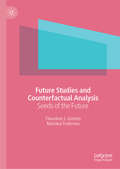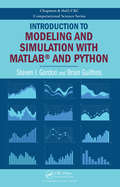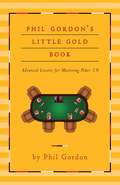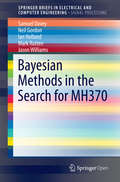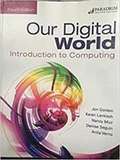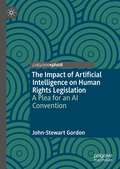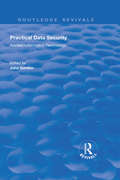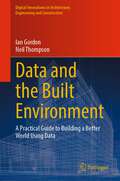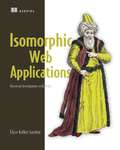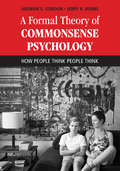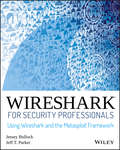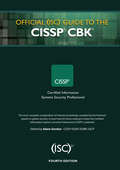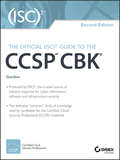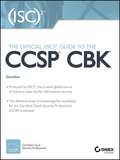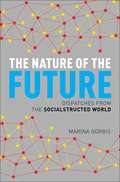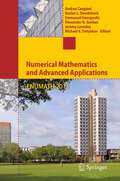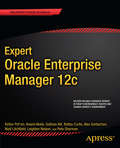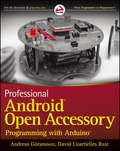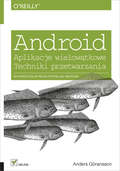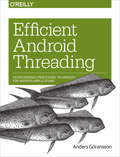- Table View
- List View
Future Studies and Counterfactual Analysis: Seeds of the Future
by Theodore J. Gordon Mariana TodorovaIn this volume, the authors contribute to futures research by placing the counterfactual question in the future tense. They explore the possible outcomes of future, and consider how future decisions are turning points that may produce different global outcomes. This book focuses on a dozen or so intractable issues that span politics, religion, and technology, each addressed in individual chapters. Until now, most scenarios written by futurists have been built on cause and effect narratives or depended on numerical models derived from historical relationships. In contrast, many of the scenarios written for this book are point descriptions of future discontinuities, a form allows more thought-provoking presentations. Ultimately, this book demonstrates that counterfactual thinking and point scenarios of discontinuities are new, groundbreaking tools for futurists.
Introduction to Modeling and Simulation with MATLAB® and Python (Chapman & Hall/CRC Computational Science)
by Steven I. Gordon Brian GuilfoosIntroduction to Modeling and Simulation with MATLAB and Python is intended for students and professionals in science, social science, and engineering that wish to learn the principles of computer modeling, as well as basic programming skills. The book content focuses on meeting a set of basic modeling and simulation competencies that were developed as part of several National Science Foundation grants. Even though computer science students are much more expert programmers, they are not often given the opportunity to see how those skills are being applied to solve complex science and engineering problems and may also not be aware of the libraries used by scientists to create those models. The book interleaves chapters on modeling concepts and related exercises with programming concepts and exercises. The authors start with an introduction to modeling and its importance to current practices in the sciences and engineering. They introduce each of the programming environments and the syntax used to represent variables and compute mathematical equations and functions. As students gain more programming expertise, the authors return to modeling concepts, providing starting code for a variety of exercises where students add additional code to solve the problem and provide an analysis of the outcomes. In this way, the book builds both modeling and programming expertise with a "just-in-time" approach so that by the end of the book, students can take on relatively simple modeling example on their own. Each chapter is supplemented with references to additional reading, tutorials, and exercises that guide students to additional help and allows them to practice both their programming and analytical modeling skills. In addition, each of the programming related chapters is divided into two parts – one for MATLAB and one for Python. In these chapters, the authors also refer to additional online tutorials that students can use if they are having difficulty with any of the topics. The book culminates with a set of final project exercise suggestions that incorporate both the modeling and programming skills provided in the rest of the volume. Those projects could be undertaken by individuals or small groups of students. The companion website at http://www.intromodeling.com provides updates to instructions when there are substantial changes in software versions, as well as electronic copies of exercises and the related code. The website also offers a space where people can suggest additional projects they are willing to share as well as comments on the existing projects and exercises throughout the book. Solutions and lecture notes will also be available for qualifying instructors.
Phil Gordon's Little Gold Book
by Phil GordonSince reigning poker expert Phil Gordon's Little Green Book illuminated the strategies and philosophies necessary to win at No Limit Texas Hold'em, poker has changed quickly and dramatically. Today, Pot Limit Omaha is the game of choice at nosebleed stakes. The players are aggressive, the games are volatile, the decisions are tough, and the pressure is relentless. This is Poker 2.0. In his Little Gold Book, Phil Gordon reexamines the game from the ground up. The key to competing with today's top players is finding the post-flop edge, but to really understand this new playing style, you need to get comfortable with the underlying math. Don't be intimidated. Gordon makes this challenging material as approachable and simple as possible. Beginning with the foundations of Poker 2.0, he unpacks the modern poker player's tool kit, rigorously examines the new lines of play in No Limit Hold'em, dissects the fast and furious strategies of Pot Limit Omaha, and explores the winning poker mind-set that will take your game to an entirely different level. The golden age of poker is upon us. Phil Gordon's Little Gold Book will shorten your learning curve, and if you're willing to put in the time and the work, big bankrolls await.
Bayesian Methods in the Search for MH370 (SpringerBriefs in Electrical and Computer Engineering)
by Neil Gordon Jason Williams Sam Davey Ian Holland Mark RuttenThis book demonstrates how nonlinear/non-Gaussian Bayesian time series estimation methods were used to produce a probability distribution of potential MH370 flight paths. It provides details of how the probabilistic models of aircraft flight dynamics, satellite communication system measurements, environmental effects and radar data were constructed and calibrated. The probability distribution was used to define the search zone in the southern Indian Ocean.The book describes particle-filter based numerical calculation of the aircraft flight-path probability distribution and validates the method using data from several of the involved aircraft’s previous flights. Finally it is shown how the Reunion Island flaperon debris find affects the search probability distribution.
Health Information Management Technology An Applied Approach 5th Edition
by Leslie L. Gordon Nanette B. SaylesCreates a blueprint for success in the health information management (HIM) field. Chapter content is expanded in the fifth edition to prepare students for transitional and changing roles in an electronic health information environment. All chapters are updated to reflect current HIM trends, practices, standards, and legal issues. Written by distinguished leaders in the field, this book guides students through two-year academic programs in preparation for the Registered Health Information Technician (RHIT) certification exam and beyond
Our Digital World: Introduction to Computing (4th Edition)
by Jon Gordon Karen Lankisch Nancy Muir Denise Seguin Anita VernoOur Digital World uses a contemporary approach to traditional computer concepts learning by integrating textbook resources with a variety of online activities. This new edition is a competency-based, objective-driven program that provides opportunities for students who want to explore topics. It provides you and your students:* Students can validate their new skills on each learning objective in the course and receive immediate feedback on Precheck and Recheck quizzes.* The SNAP customized Study Planner shares concept-level feedback and links to the resources that will help students succeed.* Numerous learning resources, such as videos, podcasts, online research, and hands-on activities, cater to different students' needs.
Our Digital World: Introduction to Computing
by Jon Gordon Karen Lankisch Nancy Muir Denise Seguin Anita VernoNIMAC-sourced textbook
Our Digital World: Introduction to Computing
by Jon Gordon Karen Lankisch Nancy Muir Denise Seguin Anita VernoThe authors of Our Digital World have done a lot of work to make the writing in this book easy to read, to find ways to get you excited about how technology is evolving, and to make computing relevant to your work and personal lives.
Our Digital World: Introduction To Computing (Second Edition)
by Jon GordonThis book provides a different learning experience by connecting this course with the way you experience computing in the twenty-first century. The activities in this book involve visiting the book's Online Companion website to view videos and Flash movies, play with interactive hands-on tools, connect with fellow students and your instructor by learning how to use collaborative features such as blogs and wikis, and discover where technology is headed by reading stories from today's headlines.
The Impact of Artificial Intelligence on Human Rights Legislation: A Plea for an AI Convention
by John-Stewart GordonThe unmatched technological achievements in artificial intelligence (AI), robotics, computer science, and related fields over the last few decades can be considered a success story. The technological sophistication has been so groundbreaking in various types of applications that many experts believe that we will see, at some point or another, the emergence of general AI (AGI) and, eventually, superintelligence. This book examines the impact of AI on human rights by focusing on potential risks and human rights legislation and proposes creating a Universal Convention for the Rights of AI Systems (AI Convention).
Practical Data Security (Routledge Revivals)
by John GordonFirst published in 1993, this volume emerged in response to the genesis of the Internet and provides early considerations on issues including computer viruses, cyber security and network encryption management, with a particular focus on applying risk analysis to the data security of financial institutions. With the stage set by the UK Data Protection Act of 1984 and the Computer Misuse Act of 1990, this volume provides a series of useful contributions for large companies and home PCs and provides a clear introduction setting out the context and the relevant terminology.
Data and the Built Environment: A Practical Guide to Building a Better World Using Data (Digital Innovations in Architecture, Engineering and Construction)
by Ian Gordon Neil ThompsonThis book takes a data-first approach to framing the built environment sector’s unique challenges and how industry can address them through better use of data. It describes how the sector has failed to derive value from data, and the common causes underlying this failure. It then provides practical guidance on how to use data to construct and operate built environment assets in a manner that better meets society’s needs. The book examines how industry norms, organizational culture, and our personal behaviours contribute to the successful use of data. It sets out a philosophy and vision for the use of data in the built environment, and how this in turn might help the sector realise better outcomes in terms of cost, schedule, quality, and sustainability. Data is a valuable asset, one that the built environment sector must generate, protect, manage, and exploit. The book works as a holistic primer to data and the built environment, written both for those who are new to data or the built environment, and including deep-dive material that will provide insight to experienced professionals.
Isomorphic Web Applications: Universal Development with React
by Elyse GordonSummaryIsomorphic Web Applications teaches you to build production-quality web apps using isomorphic architecture. Designed for working developers, this book offers examples in relevant frameworks like React, Redux, Angular, Ember, and webpack.Purchase of the print book includes a free eBook in PDF, Kindle, and ePub formats from Manning Publications.About the TechnologyBuild secure web apps that perform beautifully with high, low, or no bandwidth. Isomorphic web apps employ a pattern that exploits the full stack, storing data locally and minimizing server hits. They render flawlessly, maximize SEO, and offer opportunities to share code and libraries between client and server.About the BookIsomorphic Web Applications teaches you to build production-quality web apps using isomorphic architecture. You'll learn to create and render views for both server and browser, optimize local storage, streamline server interactions, and handle data serialization. Designed for working developers, this book offers examples in relevant frameworks like React, Redux, Angular, Ember, and webpack. You'll also explore unique debugging and testing techniques and master specific SEO skills. What's InsideControlling browser and server user sessions Combining server-rendered and SPA architecturesBuilding best-practice React applicationsDebugging and testingAbout the ReaderTo benefit from this book, readers need to know JavaScript, HTML5, and a framework of their choice, including React and Angular.About the AuthorElyse Kolker Gordon runs the growth engineering team at Strava. Previously, she was director of web engineering at Vevo, where she regularly solved challenges with isomorphic apps.Table of ContentsPART 1 - FIRST STEPSIntroduction to isomorphic web application architectureA sample isomorphic appPART 2 - ISOMORPHIC APP BASICSReact overviewApplying ReactTools: webpack and BabelReduxPART 3 - ISOMORPHIC ARCHITECTUREBuilding the serverIsomorphic view renderingTesting and debuggingHandling server/browser differences 203Optimizing for productionPART 4 - APPLYING ISOMORPHIC ARCHITECTURE WITH OTHER TOOLSOther frameworks: implementing isomorphic without ReactWhere to go from here
A Formal Theory of Commonsense Psychology: How People Think People Think
by Andrew S. Gordon Jerry R. HobbsCommonsense psychology refers to the implicit theories that we all use to make sense of people's behavior in terms of their beliefs, goals, plans, and emotions. These are also the theories we employ when we anthropomorphize complex machines and computers as if they had humanlike mental lives. In order to successfully cooperate and communicate with people, these theories will need to be represented explicitly in future artificial intelligence systems. This book provides a large-scale logical formalization of commonsense psychology in support of humanlike artificial intelligence. It uses formal logic to encode the deep lexical semantics of the full breadth of psychological words and phrases, providing fourteen hundred axioms of first-order logic organized into twenty-nine commonsense psychology theories and sixteen background theories. This in-depth exploration of human commonsense reasoning for artificial intelligence researchers, linguists, and cognitive and social psychologists will serve as a foundation for the development of humanlike artificial intelligence.
Wireshark for Security Professionals: Using Wireshark and the Metasploit Framework
by Adam Gordon Jessey BullockMaster Wireshark to solve real-world security problems If you don’t already use Wireshark for a wide range of information security tasks, you will after this book. Mature and powerful, Wireshark is commonly used to find root cause of challenging network issues. This book extends that power to information security professionals, complete with a downloadable, virtual lab environment. Wireshark for Security Professionals covers both offensive and defensive concepts that can be applied to essentially any InfoSec role. Whether into network security, malware analysis, intrusion detection, or penetration testing, this book demonstrates Wireshark through relevant and useful examples. Master Wireshark through both lab scenarios and exercises. Early in the book, a virtual lab environment is provided for the purpose of getting hands-on experience with Wireshark. Wireshark is combined with two popular platforms: Kali, the security-focused Linux distribution, and the Metasploit Framework, the open-source framework for security testing. Lab-based virtual systems generate network traffic for analysis, investigation and demonstration. In addition to following along with the labs you will be challenged with end-of-chapter exercises to expand on covered material. Lastly, this book explores Wireshark with Lua, the light-weight programming language. Lua allows you to extend and customize Wireshark’s features for your needs as a security professional. Lua source code is available both in the book and online. Lua code and lab source code are available online through GitHub, which the book also introduces. The book’s final two chapters greatly draw on Lua and TShark, the command-line interface of Wireshark. By the end of the book you will gain the following: Master the basics of Wireshark Explore the virtual w4sp-lab environment that mimics a real-world network Gain experience using the Debian-based Kali OS among other systems Understand the technical details behind network attacks Execute exploitation and grasp offensive and defensive activities, exploring them through Wireshark Employ Lua to extend Wireshark features and create useful scripts To sum up, the book content, labs and online material, coupled with many referenced sources of PCAP traces, together present a dynamic and robust manual for information security professionals seeking to leverage Wireshark.
Official: Guide to the CISSP CBK ((ISC)2 Press)
by Adam Gordon<p>As a result of a rigorous, methodical process that (ISC)² follows to routinely update its credential exams, it has announced that enhancements will be made to both the Certified Information Systems Security Professional (CISSP) credential, beginning April 15, 2015. (ISC)² conducts this process on a regular basis to ensure that the examinations and subsequent training and continuing professional education requirements encompass the topic areas relevant to the roles and responsibilities of today’s practicing information security professionals. <p>Refreshed technical content has been added to the official (ISC)² CISSP CBK to reflect the most current topics in the information security industry today. Some topics have been expanded (e.g., asset security, security assessment and testing), while other topics have been realigned under different domains. The result is an exam that most accurately reflects the technical and managerial competence required from an experienced information security professional to effectively design, engineer, implement and manage an organization’s information security program within an ever-changing security landscape.</p>
The Official (ISC)2 Guide to the CCSP CBK
by Adam GordonGlobally recognized and backed by the Cloud Security Alliance (CSA) and the (ISC)2 the CCSP credential is the ideal way to match marketability and credibility to your cloud security skill set. The Official (ISC)2 Guide to the CCSPSM CBK Second Edition is your ticket for expert insight through the 6 CCSP domains. You will find step-by-step guidance through real-life scenarios, illustrated examples, tables, best practices, and more. This Second Edition features clearer diagrams as well as refined explanations based on extensive expert feedback. Sample questions help you reinforce what you have learned and prepare smarter. Numerous illustrated examples and tables are included to demonstrate concepts, frameworks and real-life scenarios. The book offers step-by-step guidance through each of CCSP’s domains, including best practices and techniques used by the world's most experienced practitioners. Developed by (ISC)², endorsed by the Cloud Security Alliance® (CSA) and compiled and reviewed by cloud security experts across the world, this book brings together a global, thorough perspective. The Official (ISC)² Guide to the CCSP CBK should be utilized as your fundamental study tool in preparation for the CCSP exam and provides a comprehensive reference that will serve you for years to come.
The Official (ISC)2 Guide to the CCSP CBK
by GordonGlobally recognized and backed by the Cloud Security Alliance (CSA) and the (ISC)2 the CCSP credential is the ideal way to match marketability and credibility to your cloud security skill set. The" Official (ISC)2(R) Guide to the CCSPSM CBK(R) "is your ticket for expert insight through the 6 CCSP domains. You will find step-by-step guidance through real-life scenarios, illustrated examples, tables, best practices, and more. Sample questions help you reinforce what you have learned and prepare smarter. Easy-to-follow content guides you through - Major topics and subtopics within the 6 domains- Detailed description of exam format- Exam registration and administration policiesReviewed by cloud security experts, and developed by (ISC)2, this is your study guide to fully preparing for the CCSP and reaffirming your unique cloud security skills. Get ready for the next step in your career with "Official (ISC)2 Guide to the CCSP CBK". " "
The Nature of the Future: Dispatches from the Socialstructed World
by Marina GorbisA renowned futurist offers a vision of a reinvented world. Large corporations, big governments, and other centralized organizations have long determined and dominated the way we work, access healthcare, get an education, feed ourselves, and generally go about our lives. The economist Ronald Coase, in his famous 1937 paper "The Nature of the Firm," provided an economic explanation for this: Organizations lowered transaction costs, making the provision of goods and services cheap, efficient, and reliable. Today, this organizational advantage is rapidly disappearing. The Internet is lowering transaction costs--costs of connection, coordination, and trade--and pointing to a future that increasingly favors distributed sources and social solutions to some of our most immediate needs and our most intractable problems. As Silicon Valley thought-leader Marina Gorbis, head of the Institute for the Future, portrays, a thriving new relationship-driven or socialstructed economy is emerging in which individuals are harnessing the powers of new technologies to join together and provide an array of products and services. Examples of this changing economy range from BioCurious, a members-run and free-to-use bio lab, to the peer-to-peer lending platform Lending Club, to the remarkable Khan Academy, a free online-teaching service. These engaged and innovative pioneers are filling gaps and doing the seemingly impossible by reinventing business, education, medicine, banking, government, and even scientific research. Based on extensive research into current trends, she travels to a socialstructed future and depicts an exciting vision of tomorrow.
The Nature of the Future
by Marina GorbisA renowned futurist offers a vision of a reinvented world. Large corporations, big governments, and other centralized organizations have long determined and dominated the way we work, access healthcare, get an education, feed ourselves, and generally go about our lives. The economist Ronald Coase, in his famous 1937 paper "The Nature of the Firm," provided an economic explanation for this: Organizations lowered transaction costs, making the provision of goods and services cheap, efficient, and reliable. Today, this organizational advantage is rapidly disappearing. The Internet is lowering transaction costs--costs of connection, coordination, and trade--and pointing to a future that increasingly favors distributed sources and social solutions to some of our most immediate needs and our most intractable problems. As Silicon Valley thought-leader Marina Gorbis, head of the Institute for the Future, portrays, a thriving new relationship-driven or socialstructed economy is emerging in which individuals are harnessing the powers of new technologies to join together and provide an array of products and services. Examples of this changing economy range from BioCurious, a members-run and free-to-use bio lab, to the peer-to-peer lending platform Lending Club, to the remarkable Khan Academy, a free online-teaching service. These engaged and innovative pioneers are filling gaps and doing the seemingly impossible by reinventing business, education, medicine, banking, government, and even scientific research. Based on extensive research into current trends, she travels to a socialstructed future and depicts an exciting vision of tomorrow.
Numerical Mathematics and Advanced Applications 2011
by Alexander N. Gorban Andrea Cangiani Emmanuil Georgoulis Jeremy Levesley Michael V. Tretyakov Ruslan L DavidchackThe European Conferences on Numerical Mathematics and Advanced Applications (ENUMATH) are a series of conferences held every two years to provide a forum for discussion of new trends in numerical mathematics and challenging scientific and industrial applications at the highest level of international expertise. ENUMATH 2011 was hosted by the University of Leicester (UK) from the 5th to 9th September 2011. This proceedings volume contains more than 90 papers by speakers of the conference and gives an overview of recent developments in scientific computing, numerical analysis, and practical use of modern numerical techniques and algorithms in various applications. New results on finite element methods, multiscale methods, numerical linear algebra, and finite difference schemes are presented. A range of applications include computational problems from fluid dynamics, materials, image processing, and molecular dynamics.
Expert Oracle Enterprise Manager 12c
by Alex Gorbachev Anand Akela Bobby Curtis Gokhan Atil Kellyn Pot'Vin Leighton Nelson Niall Litchfield Pete SharmanEnterprise Manager 12c (EM12c), Oracle's newest and fully-integrated enterprise management product, now provides a complete cloud lifecycle management solution and enterprise environment management interface. Expert Oracle Enterprise Manager 12c opens up the secrets of this incredible management tool, saving you time while enhancing your visibility as someone management can rely upon to deliver reliable database service in today's increasingly chaotic and change-driven IT environment. Expert Oracle Enterprise Manager 12c covers all the topics you demand and need to function effectively, from basic monitoring and configuration to advanced metric extensions and plugins. Real-life scenarios and demonstrations place you in the comfort zone of using the EM12c console, and the experienced author team provides deep understanding of the inner workings of this new Enterprise Manager. Database administrators and system administrators are expected to offer increasing levels of service for 24X7 systems and newer cloud environments. Em12c offers robust, end-to-end intelligent management of the complete environment. It includes direct, real-time integration with Oracle's online knowledgebase. Expert Oracle Enterprise Manager 12c helps you master this important tool and manage any challenge that comes your way. Provides example solutions to everyday problems through EM12c features. Explains the changes in EM12c, included trusted extensions. Focuses on advanced aspects of the EM12c interface.
Professional Android Open Accessory Programming with Arduino
by Andreas Goransson David Cuartielles RuizLearn how to control your home or car from your Android smartphone - air conditioning, lights, entertainment systems, and more!Android Open Accessory is a new, simple, and secure protocol for connecting any microcontroller-empowered device to an Android smartphone or tablet. This Wrox guide shows Android programmers how to use AOA with Arduino, the microcontroller platform, to control such systems as lighting, air conditioning, and entertainment systems from Android devices. Furthermore, it teaches the circuit-building skills needed to create games and practical products that also take advantage of Android technology. Introduces Android Open Accessory and shows how to set up the hardware and development environmentExplains how to code both Android and Arduino elements of an accessoryFeatures four complete projects developers can build using various sensors and indicators/actuators, including source codeGives Android developers the tools to create powerful, sophisticated projectsProfessional Android Open Accessory with Android ADK and Arduino opens exciting new opportunities for Android developers.
Android. Aplikacje wielow?tkowe. Techniki przetwarzania
by Anders GoranssonWykorzystaj w pe?ni potencja? w?tków! Je?eli chcesz tworzy? aplikacje dostarczaj?ce u?ytkownikom doskona?ych wra?e?, je?eli chcesz wykonywa? skomplikowane zadania szybciej lub po prostu musisz jednocze?nie wykonywa? ró?ne dzia?ania — naucz si? korzysta? z w?tków. Tworzenie programów wielow?tkowych jest trudne, ale opanowanie tej sztuki pozwoli Ci osi?gn?? wymierne korzy?ci!Ta ksi??ka w ca?o?ci po?wi?cona jest korzystaniu z w?tków na platformie Android. Dzi?ki niej poznasz przeró?ne sposoby asynchronicznego przetwarzania oraz ich zalety i wady. Jednak na samym pocz?tku zapoznasz si? z podstawowymi informacjami dotycz?cymi wielow?tkowo?ci w j?zyku Java. Dowiesz si?, w jaki sposób w?tki komunikuj? si? ze sob? i synchronizuj? dost?p do zasobów oraz jak nimi zarz?dza?. Kolejne rozdzia?y zawieraj? spor? dawk? wiedzy na temat ró?nych technik asynchronicznych. Zapoznanie si? z ich tre?ci? u?atwi Ci wybór techniki, która spe?ni Twoje wymagania, gdy sam zabierzesz si? za tworzenie aplikacji wielow?tkowej. Ksi??ka ta jest obowi?zkow? lektur? dla programistów chc?cych w pe?ni wykorzysta? mo?liwo?ci platformy Android. Podstawy wielow?tkowo?ci w Javie i systemie Android. Komunikacja w?tków w obr?bie procesu i pomi?dzy procesami. Zastosowanie strategii redukowania ryzyka powstawania wycieków pami?ci. Zarz?dzanie cyklem ?ycia w?tku podstawowego. Sekwencyjne uruchamianie zada? w w?tku t?a za pomoc? klasy HandlerThread. U?ywanie frameworku wykonawcy Javy do kontrolowania i anulowania w?tków. Obs?uga wykonywania zada? w tle za pomoc? klas AsyncTask oraz IntentService. Uzyskiwanie dost?pu do dostawców tre?ci za pomoc? klasy AsyncQueryHandler. U?ywanie ?adowarek do aktualizowania interfejsu u?ytkownika nowymi danymi.Przewodnik po ?wiecie w?tków platformy Android!
Efficient Android Threading
by Anders GoranssonMultithreading is essential if you want to create an Android app with a great user experience, but how do you know which techniques can help solve your problem? This practical book describes many asynchronous mechanisms available in the Android SDK, and provides guidelines for selecting the ones most appropriate for the app you're building.Author Anders Goransson demonstrates the advantages and disadvantages of each technique, with sample code and detailed explanations for using it efficiently. The first part of the book describes the building blocks of asynchronous processing, and the second part covers Android libraries and constructs for developing fast, responsive, and well-structured apps.Understand multithreading basics in Java and on the Android platformLearn how threads communicate within and between processesUse strategies to reduce the risk of memory leaksManage the lifecycle of a basic threadRun tasks sequentially in the background with HandlerThreadUse Java's Executor Framework to control or cancel threadsHandle background task execution with AsyncTask and IntentServiceAccess content providers with AsyncQueryHandlerUse loaders to update the UI with new data
